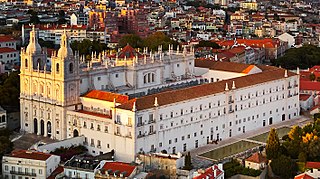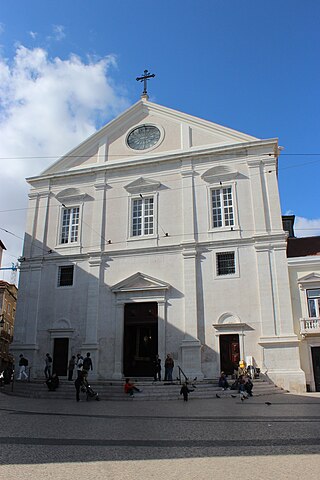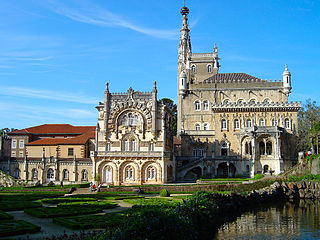
Baroque architecture is a highly decorative and theatrical style which appeared in Italy in the early 17th century and gradually spread across Europe. It was originally introduced by the Catholic Church, particularly by the Jesuits, as a means to combat the Reformation and the Protestant church with a new architecture that inspired surprise and awe. It reached its peak in the High Baroque (1625–1675), when it was used in churches and palaces in Italy, Spain, Portugal, France, Bavaria and Austria. In the Late Baroque period (1675–1750), it reached as far as Russia, the Ottoman Empire and the Spanish and Portuguese colonies in Latin America. In about 1730, an even more elaborately decorative variant called Rococo appeared and flourished in Central Europe.

The Manueline, occasionally known as Portuguese late Gothic, is the sumptuous, composite Portuguese architectural style originating in the 16th century, during the Portuguese Renaissance and Age of Discoveries. Manueline architecture incorporates maritime elements and representations of the discoveries brought from the voyages of Vasco da Gama and Pedro Álvares Cabral. This innovative style synthesizes aspects of Late Gothic Flamboyant architecture with original motifs and influences of the Plateresque, Mudéjar, Italian, and Flemish architecture. It marks the transition from Late Gothic to Renaissance. The construction of churches and monasteries in Manueline was largely financed by proceeds of the lucrative spice trade with Africa and India.

The Jerónimos Monastery or Hieronymites Monastery is a former monastery of the Order of Saint Jerome near the Tagus river in the parish of Belém, in the Lisbon Municipality, Portugal. It became the necropolis of the Portuguese royal dynasty of Aviz in the 16th century but was secularized on 28 December 1833 by state decree and its ownership transferred to the charitable institution, Real Casa Pia de Lisboa.

The Monastery of Batalha is a Dominican convent in the municipality of Batalha, in the district of Leiria, in the Centro Region of Portugal. Originally, and officially, known as the Monastery of Saint Mary of the Victory, it was erected in commemoration of the 1385 Battle of Aljubarrota and would serve as the burial church of the 15th-century Aviz dynasty of Portuguese royalty. It is one of the best and original examples of Late Flamboyant Gothic architecture in Portugal, intermingled with the Manueline style. The monastery is a historic and cultural monument and was listed as a UNESCO World Heritage site in 1983.

The Monastery of the Holy Cross, also known as the Church of the Holy Cross, is a National Monument in Coimbra, Portugal. Because the first two kings of Portugal are buried in the church it was granted the status of National Pantheon. Founded in 1131 outside the protecting walls of Coimbra, the Monastery of the Holy Cross was the most important monastic house during the early days of the Portuguese monarchy. Saint Theotonius founded this community of Canons Regular of the Holy Cross of Coimbra and served as their first prior. The monastery and church were erected between 1132 and 1223. The monastery was granted numerous papal privileges and royal grants, which allowed the accumulation of considerable wealth, at the same time as it consolidated its position on the politico-institutional and cultural scene. Its school, with its vast library, was highly respected in medieval times and was a meeting point for the intellectual and power elites. Its scriptorium was used for the consolidation of royal power by King Afonso Henriques, thus it was not considered strange that he decided to be buried there.

The Church and Monastery of São Vicente de Fora, meaning "Monastery of St. Vincent Outside the Walls", is a 17th-century church and monastery in the city of Lisbon, Portugal. It is one of the most important monasteries and mannerist buildings in the country. The monastery also contains the royal pantheon of the Braganza monarchs of Portugal.

The Alcobaça Monastery or Alcobasa Monastery is a Catholic monastic complex located in the town of Alcobaça, in central Portugal, 120 km (75 mi) north of Lisbon and 110 km (68 mi) south of Coimbra.

The Monastery of Jesus is a historical religious building in Setúbal, Portugal, which served a monastery of Poor Clare nuns. It is one of the first buildings in the Manueline style, the Portuguese version of late Gothic. The cloisters of the complex houses a museum of the monastery. In 2013, pan-European heritage organization Europa Nostra declared the monastery to be one of the 7 most endangered monuments in Europe.

The Convent of Our Lady of Mount Carmel is a former Catholic convent located in the civil parish of Santa Maria Maior, municipality of Lisbon, Portugal. The medieval convent was ruined during the sequence of the 1755 Lisbon earthquake, and the destroyed Gothic Church of Our Lady of Mount Carmel on the southern facade of the convent is the main trace of the great earthquake still visible in the old city.

Diogo de Boitaca was an influential architect and engineer of some of the most important Portuguese buildings, working in Portugal in the first half of the 16th century.

Portuguese architecture refers to both the architecture of Portugal's modern-day territory in Continental Portugal, the Azores and Madeira, as well as the architectural heritage/patrimony of Portuguese architects and styles throughout the world, particularly in countries formerly part of the Portuguese Empire.

Portuguese Gothic architecture is the architectural style prevalent in Portugal in the Late Middle Ages. As in other parts of Europe, Gothic style slowly replaced Romanesque architecture in the period between the late 12th and the 13th century. Between the late 15th and early 16th century, Gothic was replaced by Renaissance architecture through an intermediate style called Manueline.

The ruins of the Monastery of Santa Clara-a-Velha are located in the city of Coimbra, in Portugal. The monastery was built in the 14th century on the left bank of the Mondego River, but had to be abandoned in the 17th century due to frequent floods. The well-preserved Gothic ruins of the monastery were excavated in the late 20th century, more than 300 years after being abandoned by the nuns.

Baroque architecture in Portugal lasted about two centuries. The reigns of John V and Joseph I had increased imports of gold and diamonds, in a period called Royal Absolutism or Absolute monarchy, which allowed the Portuguese Baroque to flourish.

The Igreja de São Roque is a Catholic church in Lisbon, Portugal. It was the earliest Jesuit church in the Portuguese world, and one of the first Jesuit churches anywhere. The edifice served as the Society's home church in Portugal for over 200 years, before the Jesuits were expelled from that country. After the 1755 Lisbon earthquake, the church and its ancillary residence were given to the Lisbon Holy House of Mercy to replace their church and headquarters which had been destroyed. It remains a part of the Holy House of Mercy today, one of its many heritage buildings.

Gilded woodcarving in Portugal is, along with azulejos, one of the country's most original and rich artistic expressions. It is usually used in the interior decoration of churches and cathedrals and of noble halls in palaces and large public buildings. An impressive collection of altarpieces are found in Portuguese churches. Originating in the Gothic era, Portuguese gilded woodcarving assumed a nationalist character during the 17th century and reached its height in the reign of King D. João V. In the 19th century it lost its originality and began to disappear with the end of the revival era.
João Antunes (1642–1712) was a Portuguese architect and master mason, considered to be one of the most important architects of Baroque architecture. Antunes served as royal architect during the reign of King Pedro II of Portugal and is responsible for a number of famous landmarks in Lisbon, such as the National Pantheon at Santa Engrácia, and the tomb of Saint Joana, Princess of Portugal.

The Buçaco Palace is a former convent that today houses a luxury hotel located in the Buçaco mountain range, in the municipality of Mealhada, in central Portugal. It is a national monument.

The Real Monasterio de la Encarnación is a convent of the order of Recollet Augustines located in Madrid, Spain. The institution mainly interned women from noble families, and was founded by the Queen Margaret of Austria, wife of Philip III, and thus was well endowed with wealth. Although it belongs to an enclosed religious order, the building is open to the public under the administration of the Patrimonio Nacional.

The Portuguese Renaissance refers to the cultural and artistic movement in Portugal during the 15th and 16th centuries. Though the movement coincided with the Spanish and Italian Renaissances, the Portuguese Renaissance was largely separate from other European Renaissances and instead was extremely important in opening Europe to the unknown and bringing a more worldly view to those European Renaissances, as at the time the Portuguese Empire spanned the globe.


















